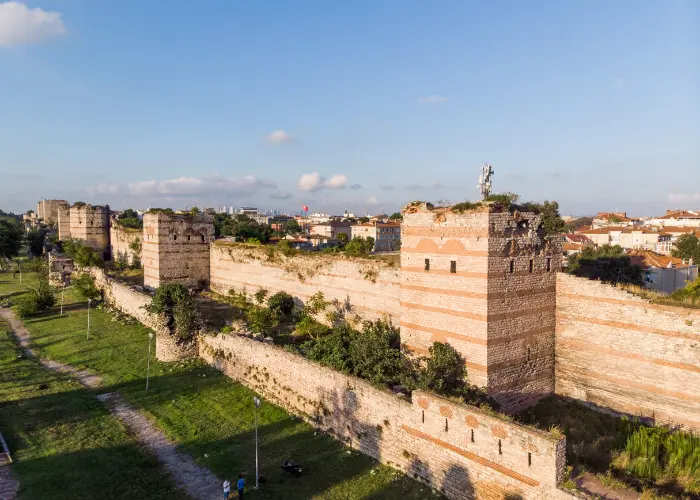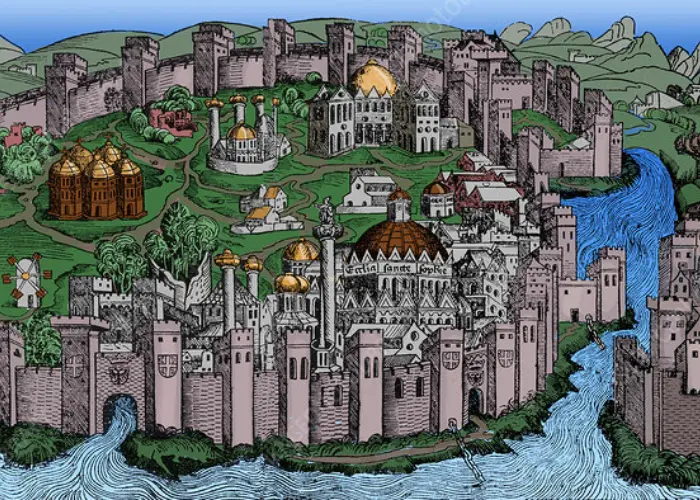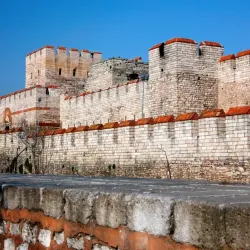Constantinople, the "Queen of Cities," stood as the heart of the Byzantine Empire for over a millennium. Its strategic location on the Bosphorus Strait, connecting Europe and Asia, made it a crossroads of civilizations and a center of immense wealth and power. The city's grand architecture, including the iconic Hagia Sophia and the Topkapi Palace, reflects its rich history and cultural significance.
Beyond its architectural marvels, Constantinople was a hub of intellectual and artistic pursuits. Its scholars and artisans produced groundbreaking works in philosophy, science, and art, influencing the development of European civilization. The city's libraries and universities attracted scholars from across the known world, fostering a vibrant intellectual atmosphere. Constantinople's legacy extends far beyond its physical remains, shaping the course of history and leaving an enduring mark on the world.
Establishment and Byzantium Period
The history of Istanbul began thousands of years ago. But, firstly, Megarians were the settlers in Istanbul in the 7th century B.C.E. Megaran was a city-state in Ancient Greece. Byzas, king of Megara, wanted to establish a new city-state, so he went to the Temple of Apollo and consulted an oracle. Oracle said “You should establish against the country of the blind.” Byzas was confused. While he was walking, he looked at Kadiköy from Sarayburnu. He thought that while this area was more remarkable, why did people find a city there? Anyone, who founded a town there, must be blind. And he decided where to establish the city. And Megarians founded a city in 667 B.C.E. The city’s name was Byzantion. Byzantium is the first name before Constantinople and Istanbul.
Roman Empire Period of Constantinople
Byzantium continued as an ordinary and unimportant city till the 4th Century. However, Byzantium started to be important because of its location after Constantine became the emperor of the Roman Empire.
Constantine was important to the history of Istanbul as Constantine considered moving the capital to another city. He considered Izmit, Troy, and Byzantion, and he chose Byzantion because it sat at the end of important trade routes. Also, Byzantium was built upon the land of seven hills like Rome. The city became the capital city 65 years ago before the Roman Empire separated. The city was mentioned as Constantinople after Constantine’s death.
In the Constantine period, the city began to change and develop. Constantine didn’t ruin the city. He designated town borders. Constantine got the palace done for people who came from Milano. Hippodromes were built, and walls started to be renewed in Constantinople. We can say that the history of Istanbul was initiated in this period.
![]()

![]()
After Constantine’s death, the Emperors continued developing the city. During the Theodosius Period (379-395), he built a harbor to find a solution to the food problem. He got the warehouse done. Forum Tauri, now known as Beyazid Square, was built in this period. In 395, the Roman Empire was split into two parts East-Rome and Western-Rome. Western Rome’s capital city became Milano, and East- Rome’s capital city, was Constantinople. The city was built as a city for Christians after Emperor Theodosius signed the edict of Thessaloniki. In time, the city became the center of Christianity.
Constantinople continued to improve and change in the II. Theodosius Period. Walls extended and cultivated areas, and structures were put under protection. During this time, Constantinople reached its most magnificent state. The situation continued until the Roman Empire collapsed. In the 465 Emperor Leon period, a fire started in Constantinople, and it destroyed half of the city. After the fire, the city began to renew. But in the Justinian I Period, Nika riots began, and the civil commotion ruined the city again. Justinian I suppressed the Nika Riots, and he started to design new architecture, and he decided to build a new Church. The Church’s name was Hagia Sophia. He built the Basilica Cistern and the Binbirdirek Cistern. And he changed the official language to the Helen language.
After Justinian I, the unproductive period started in the Roman Empire. But constructions started again in Constantinople in Theophilos and Basileios I Period. Churches and monasteries were built in this period. Many of the buildings still are in Constantinople.
The Latin Occupation: A Dark Chapter in Constantinople's History
The Fourth Crusade, initially intended to liberate Jerusalem from Muslim rule, took a devastating turn when it was diverted to Constantinople. In 1204, a Crusader army, primarily composed of Venetian and French forces, laid siege to the city, ultimately sacking and occupying it. This marked the beginning of the Latin Empire, a short-lived Western European state that ruled over parts of the former Byzantine Empire.

During the Latin occupation, Constantinople suffered immense destruction. The city's renowned Hagia Sophia was desecrated and converted into a Roman Catholic cathedral. Countless priceless artifacts and relics were looted and dispersed across Europe. The city's once-thriving economy and cultural life were shattered. The Latin Empire's rule, however, was ultimately short-lived. In 1261, the Byzantine Empire, under the leadership of Michael VIII Palaiologos, reclaimed Constantinople, marking a significant turning point in the city's history.
The Byzantine Empire After the Latin Occupation: A Period of Decline and Resilience
The recapture of Constantinople by Michael VIII Palaiologos in 1261 marked a significant turning point, but the city had been irrevocably scarred by the Latin occupation. The once-glorious metropolis was diminished, its wealth plundered, and its infrastructure damaged. Despite the Byzantine Empire's efforts to restore its former glory, it faced numerous challenges, including internal strife, economic decline, and external threats.
The Ottoman Empire, a rising Islamic power, posed the most serious threat to Constantinople. Over the centuries, the Ottomans gradually expanded their territory, encroaching on Byzantine lands. The city itself was besieged multiple times, with each siege testing its defenses and resilience. While the Byzantines managed to withstand these attacks, the empire's gradual weakening made it increasingly vulnerable.
The Ottoman conquest of Constantinople in 1453 marked the end of the Byzantine Empire and the beginning of a new era for the city.
The Ottoman Conquest: The Fall of Constantinople
Despite the setbacks and challenges faced by the Byzantine Empire, Constantinople remained a formidable fortress. However, the rise of the Ottoman Empire posed a significant threat to the city's existence. In the late 14th and early 15th centuries, Ottoman sultans, including Bayezid I and Murad II, attempted to conquer the city but were thwarted by various factors, such as internal conflicts and external pressures.
The turning point came in 1453, when Sultan Mehmed II, known as Mehmed the Conqueror, laid siege to Constantinople. After a grueling 53-day siege, the Ottoman forces breached the city's defenses, conquering it on May 29, 1453. The fall of Constantinople marked the end of the Roman Empire and ushered in a new era for the city. Under Ottoman rule, Constantinople underwent a significant transformation. The Hagia Sophia was converted into a mosque, and the city became the capital of the Ottoman Empire, serving as a cultural and economic center for centuries.
 English
English  Indonesian
Indonesian  Urdu
Urdu  Taiwanese
Taiwanese  Russian
Russian  Romanian
Romanian  Portuguese
Portuguese  Persian
Persian  Macedonian
Macedonian  Korean
Korean  Japanese
Japanese  Italian
Italian  Indian
Indian  Hungarian
Hungarian  Greek
Greek  German
German  Croatian
Croatian  Chinese
Chinese  Bulgarian
Bulgarian  Arabic
Arabic  French
French  Spanish
Spanish 





